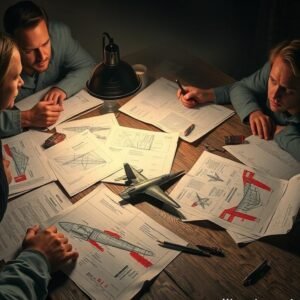The Lost Army of Cambyses: The Enigma of 50,000 Soldiers Swallowed by the Desert!

Cambyses’ Lost Army: Sahara Desert Mystery
Where does an army of 50,000 soldiers disappear? Not on a battlefield, nor in the midst of war, but in the sands of the Sahara Desert, which seemingly consumed them without a trace. In this episode, we embark on an exploratory journey into the heart of the Sahara to investigate the mystery of Cambyses’ lost army and examine how the aspirations of a great Persian empire were reduced to a mere whisper in the wind. From the conflicting accounts of Herodotus, which raise significant questions, to ancient maps potentially holding buried secrets, and local legends passed down through generations, we will confront the stark reality that the grandeur of kings and their power pales in comparison to the forces of nature. Was Cambyses a victim of his own hubris? Or does the desert conceal a more profound secret, awaiting discovery?
Before we commence our investigation, please share your thoughts and expectations in the comments section. And be sure to subscribe to the channel for the latest updates.
The Rise and Fall of Cambyses II
As we consider the fate of Cambyses’ lost army in the desert, let us journey back to the zenith of the Persian Empire to explore the character of Cambyses II, the ambitious king who instigated this tragic event. In 530 BC, Cambyses II ascended to the throne following the death of his father, Cyrus the Great, the founder of the Persian Empire. Cambyses inherited a formidable legacy, but his ambition was boundless. Egypt, the last of the great independent powers in the region, presented an irresistible target.
In 525 BC, Cambyses achieved a decisive victory at the Battle of Pelusium, resulting in the subjugation of Egypt and the end of the Twenty-sixth Dynasty. However, Cambyses’ ambitions extended beyond Egypt; he subsequently turned his attention south towards Nubia and Ethiopia, initiating campaigns that proved less successful. It is at this point that historical narratives diverge. The Greek historian Herodotus portrays Cambyses as a tyrannical ruler who committed egregious atrocities, including the murder of his brother Smerdis and the desecration of Egyptian deities. However, despite this negative depiction, some evidence suggests that Cambyses initially pursued a policy of respect for local religions. In 522 BC, Cambyses’ life ended under mysterious circumstances while returning from Egypt, plunging the empire into a period of turmoil and conflict, ultimately paving the way for Darius I to assume power. Was this enigmatic demise merely coincidental, or does it conceal a deeper truth?
The Strategic Importance of Siwa Oasis
But why Siwa in particular? Situated in the heart of the vast Western Desert, the Siwa Oasis is a vibrant center of life, representing not merely an isolated green space, but a strategic asset of considerable value. In 525 BC, following Cambyses’ decisive military victory over Egypt, the subjugation of ancient Egypt alone was insufficient to satisfy his ambition. Siwa, with its unique characteristics, posed a significant challenge to the burgeoning Persian Empire. The oasis was not simply a territory, but a center for the worship of Amun, the revered god of the sun and air, and its temple held profound spiritual significance for the Egyptians. Furthermore, Siwa served as a crucial junction on the desert caravan route, connecting Egypt to the resources of the African interior. Its high-quality dates and salt were valuable commodities, flowing through the desert like vital arteries, sustaining trade and the economy.
However, the significance of Siwa extended beyond commerce, reaching the core of imperial control. Siwa enjoyed a degree of autonomy, resisting the centralized authority in Egypt. Cambyses, driven by his relentless ambition, sought to extend his influence to every corner of his new kingdom. Subjugating Siwa would solidify his control over desert trade and ensure unwavering allegiance to Amun. This ambition transcended mere expansionism, becoming a direct challenge to Persian prestige. Just years prior, at the Battle of Pelusium, Cambyses’ forces had crushed Egypt, establishing his reputation as an unparalleled conqueror. Now, he needed to reaffirm this dominance decisively.
The March into the Unknown
Envision an army of fifty thousand soldiers, a formidable force comprised of resilient Persians, skilled Greeks, and mercenaries from distant lands. A massive army in every sense, with abundant supplies sufficient to subdue vast empires. Herodotus himself described them as an invincible force, before the desert sands seemingly swallowed them whole. They spent fifty days traversing the Sahara, their advanced military tactics preceding them, the cavalry charging in a display of power, and the heavy infantry marching relentlessly.
While the initial fifty days were spent crossing the barren landscape, the subsequent fifty days would test them in unforeseen ways. Imagine the sun transforming into a furnace, scorching everything with temperatures exceeding fifty degrees Celsius. Not merely heat, but an intense inferno. Each soldier required at least ten liters of water daily simply to survive. Ten liters, an immense quantity, in this extreme environment! But where would they obtain such a volume of water? The Siwa Oasis, their intended destination, lay hundreds of kilometers away. Imagine the camel caravans, burdened with supplies, yet even these “ships of the desert” could not carry enough to quench the thirst of an entire army. Then, the Khamsin winds would arrive, unleashing hellish storms that obscured vision and intensified thirst. Days would fade into dark nights, amidst a suffocating sandy darkness.
In 1933, a British expedition, equipped with modern trucks, required ten days to traverse a small portion of this desert. Consider Cambyses’ army, facing this scorching torment without modern assistance. The vast sand dunes lay in wait, the barren rocky plains added to their burden, and the rugged mountains tested their resolve. Every step was a fierce struggle, and every breath was an ordeal. It was a journey of death in every sense. The sounds of armies fade, but the stories remain. And the official narrative, the most widely circulated, possesses a deadly simplicity akin to a raging sandstorm. Herodotus, the renowned Greek historian, recounts that Cambyses’ massive army, consisting of fifty thousand soldiers, departed from Thebes towards the Siwa Oasis. While the soldiers were taking a midday meal under the scorching desert sun, a fierce southern wind suddenly arose, burying them alive beneath the accumulated dunes.
The Desert’s Secrets: Theories and Speculations
The Siwa Oasis, a verdant haven defying the harsh desert environment, represented a strategic objective of considerable importance to the ambitious Persian king. Controlling it offered not only commercial advantages through control of vital caravan routes, but also the potential to secure the allegiance of the desert gods, believed to control the destinies of travelers. However, the desert itself seemingly refused to yield, choosing to protect its buried secrets. Herodotus, considered a primary source for this era, recorded his account decades after the event. But was the sandstorm truly the sole cause? Or does it serve as a screen concealing a more ignominious defeat?
Pomponius Mela, writing centuries later, adds another layer to this perplexing puzzle, suggesting that quicksand swallowed the entire Persian army. Quicksand engulfing fifty thousand soldiers? Is this scenario merely a fabrication? Or did other forces intervene to alter the fate of these invaders? Whispers of history recount tales of fierce resistance from desert tribes, who defended their land with unwavering tenacity. Is it possible that this massive army fell into a well-laid ambush, a victim of the local population’s knowledge of the desert terrain? We cannot dismiss the possibility of internal rebellion. An army of this size, suffering from severe shortages of supplies and water, may have disintegrated from within. Did the soldiers lose patience, and did their anger erupt against their leader Cambyses, known for his recklessness?
The most mysterious and speculative accounts suggest the involvement of the priests of Amun in Siwa. Did they incite sedition within the Persian army in retaliation for Cambyses’ desecration of their temples in the north? These remain mere speculations, fueled by the scarcity of archaeological evidence. To date, no conclusive evidence has been found indicating a decisive battle or a mass massacre in that vast area. However, amidst these speculations, one fundamental question echoes across the sands of time: Where is the evidence? Where are the tangible remains that definitively prove that Cambyses’ army traversed this desolate desert?
The Absence of Evidence: A Lingering Doubt
Despite the passage of centuries and sporadic surveys, no mass graves of Persian soldiers, nor weapons or military equipment dating back to that era, have been discovered. Some believe that the desert sands are capable of concealing any trace, and that continuous erosion and the movement of sand dunes may have obliterated all evidence. However, this explanation is not entirely convincing. The absence of conclusive material evidence casts doubt on the entire historical narrative. Is it merely a legend passed down through generations, or is the truth more complex than we imagine? While some Persian artifacts have been found elsewhere in Egypt, none are directly linked to Cambyses’ lost army. Even unconfirmed reports of the discovery of metal tools and skeletons in the Western Desert remain speculative, lacking independent confirmation linking them to the Persian army. Furthermore, Herodotus himself, the primary source of the story, relied on Egyptian sources for his information, raising questions about the accuracy of the details and the possibility of exaggeration or distortion.
Legends of the Oasis
But what of the stories told by the people of the oasis themselves? Legends and tales that have become ingrained in the collective memory of generations, speaking of the fate of Cambyses’ lost army. The legend says,








